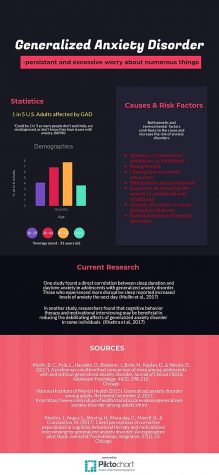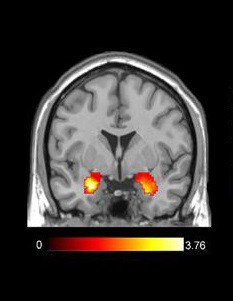Life with Generalized Anxiety Disorder
May 4, 2018
You’re standing at the bottom of a stage, about to be called up in front of a crowd of over a thousand people to give a speech that you do not have and that famous feeling returns to you. The knot in the gut, butterflies in the stomach feeling, also known as nervousness. You think the world is going to end because of this terrible turmoil tearing up your insides, and your mind is racing. It will not stop; it keeps going and going until you cannot take it anymore and breakdown.
This is the life of a person with generalized anxiety disorder.

Generalized anxiety disorder (G.A.D.) affects 6.8 million adults or 3.1 percent of the U.S. population and is characterized by the “persistent and excessive worry about a number of different things.” The disorder is treatable, however, only 36.9 percent of those suffering receive treatment.
As a person with anxiety, I have firsthand experience with living in fear of the uncertain. I know what it is like to overthink a situation to the point of panic, to the point where everything could either lead me to embarrassment or death.
My feelings of anxiousness regarding social situations began in eighth grade after I moved to a brand new school. I would avoid talking to other fellow students and teachers at all costs. I had no friends and no one to talk to about my situation. Everyday, I woke up feeling like I needed to vomit from the nervousness. In September of 2015, I was diagnosed with anxiety after suffering from a panic attack every night for a month leading up to ninth grade. A panic attack looks and feels different for everyone, but for me, it consisted of light and unsteady breathing, shaking, the inability to focus, nausea, restlessness and crying.

The combination of crippling nervousness with the stress of school only worsened things after my diagnosis. I had several mental breakdowns; one prevented me from buckling my own seat-belt. My anxiety caused me to lose sleep, but a lack of sleep made everything worse. In addition, the constant overthinking that I experienced caused me to miss beneficial opportunities. I almost skipped out on the eighth grade field trip just because it was out of my routine until my parents forced me to go.
Overtime, I slowly made friends, and being around them helped me to somewhat overcome my fear of striking up a conversation. I met people who worried like me, and we bonded over our irrational worries. I taught myself a breathing technique in order to relieve some of the panic and developed a list of everything that makes me feel better. In return, my experience with panic and breakdowns helped me to calm people down and work them through a breakdown.

I still have anxiety; it is hard to overcome any mental illness. However, stepping out of my comfort zone, making friends and finding healthy coping mechanisms have helped to relieve some of the stress of living with a disorder.




